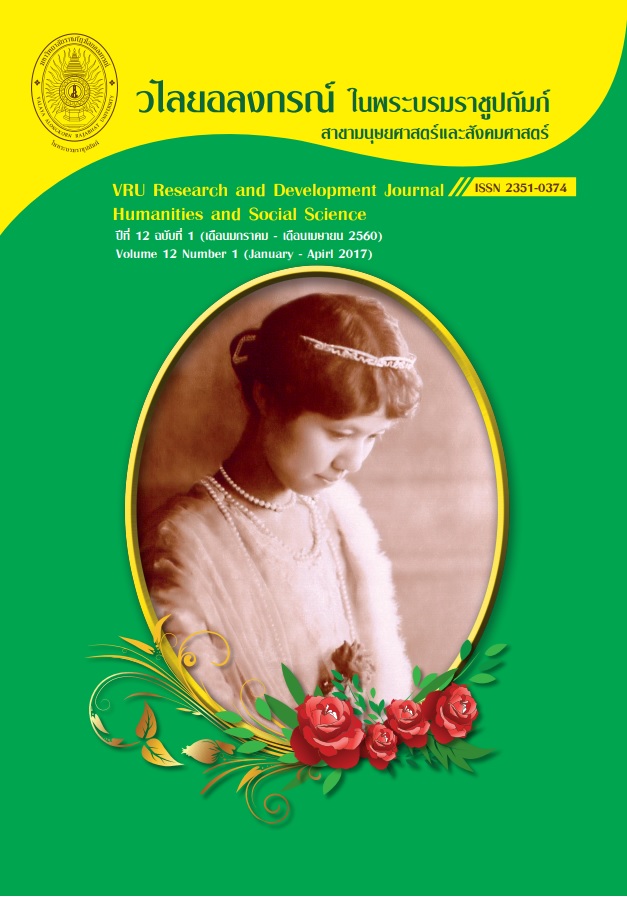Evaluation Pattern for the Health of Diabetes Patients with Traditional Herbs by the Environmental Education
Main Article Content
Abstract
This research aimed to evaluate the use of the pattern for the health of diabetes patients with traditional herbs by the environmental education (PTEE). PTEE for the patients to participate in learning practice with 5 step activities, (1) problem recognition (2) learning activities (3) awareness building (4) skill building and (5) participation with family members in the pattern for six months. We evaluated the use of PTEE, compared the knowledge, awareness, and behavior before and after using this pattern, evaluated the participant’s satisfaction toward PTEE, compared the amount of blood sugar before and after participating in the activities set according to PTEE. 60 diabetes patients who were service recipients at Diabetes Clinic, Kabinburi Hospital were selected by purposive sampling method and divided to two sets of the research instrument; (1) test format of knowledge, awareness, and behavior (2) evaluation form on satisfaction toward PTEE and the family members who were their caretakers. The result of using PTEE show that diabetes patients received overall more knowledge, awareness, and behavior in using traditional herbs than before using PTEE (p=.05) and satisfied with PTEE at high level. The factor that received the highest satisfaction was skill building by practicing, learning to use appropriate herbs by lecturing, respectively. Patient’s relatives were satisfied with PTEE at high level, learning to use appropriate herbs by lecturing show the highest satisfaction and participation by encouraging family members in self-care planning and exchanging learning experiences, respectively. Blood sugar after six months of samples were lower at P= 0.05
Article Details
ลิขสิทธิ์บทความวิจัยที่ได้รับการตีพิมพ์เผยแพร่ในวารสารมนุษยศาสตร์และสังคมศาสตร์ วไลยอลงกรณ์ ในพระบรมราชูปถัมภ์ ถือเป็นกรรมสิทธิ์ของคณะมนุษยศาสตร์และสังคมศาสตร์ มหาวิทยาลัยราชภัฏวไลยอลงกรณ์ ในพระบรมราชูปถัมภ์ ห้ามนำข้อความทั้งหมดหรือบางส่วนไปพิมพ์ซ้ำ เว้นแต่จะได้รับอนุญาตจากมหาวิทยาลัยเป็นลายลักษณ์อักษร
ความรับผิดชอบ เนื้อหาต้นฉบับที่ปรากฏในวารสารมนุษยศาสตร์และสังคมศาสตร์ วไลยอลงกรณ์ ในพระบรมราชูปถัมภ์ เป็นความรับผิดชอบของผู้นิพนธ์บทความหรือผู้เขียนเอง ทั้งนี้ไม่รวมความผิดพลาดอันเกิดจากเทคนิคการพิมพ์
References
Strategy and Planning Group, Bureau of the Non-Comminucable Disease (2014). Annual Report 2014. Bangkok: Office of WVO Printing Mill under Royal Patronage.
Kabin Buri Hospital. 2016. Outpatient Medical Records. Sakeaw,Thailand.
Kanthika Thaweerod and Trithip Anongthong (2007). Knowledge and Practice of the Diabetes
Patients who Received Medical Care at Diabetes Clinic of Hua Pho Community Health Center, Hua Pho Sub-District,Bang Phae District, Ratchaburi Province, Field of Study: Community Health, Faculty of Sciences and Technology, Nakhon Pathom Rajabhat University.
Chonlakarn Songsri (2007). A Developing Pattern of Self-Care Promotion for Diabetes Mellitus Type 2 Patients at Thung Fon Hospital, Thung Fon District, Udon Thani Province. (Thesis) Master of Arts in Strategic Development, Rajabhat Udon Thani University.
Nawaphat Wutthitham (2011). A Study of Developing Strategy for Health Behavior Change of Diabetes Mellitus Patients with the Technique of “Love, Listening. Self-efficacy, and Learning (LLSL)” Treated by the Diabetes Clinic of Banlad Hospital Network in Petchaburi Province. Nursing Journal. Vol 38.No.3 July-Sep 2011, 146 - 157
Nannaphat Piraphrutthiphong, et al. (2012). The Effect of the Self-Management Program on Knowledge, Self- Care Activities and HbA1C in Persons with Diabetes Mellitus Type 2. Journal of the North Eastern Region Nursing Society. Vol.30. No.2 Apr-June 2012,.98-105
Nutcharee Arbsuwan (2016). Key Campaign Message on World Diabetes’ Day 2015 (Fiscal Year 2016).Bureau of Non Communicable Diseases, Department Diseases Control. Ministry of Public Health
Prapasri Tanakool (2016). Health Behavior and the Use of Traditional herbs Enhancing Health of Diabetes Mellitus Type 2 Patients. National Academic Conference 2016, College of Innovative Management, Valai alongkorn Rajabhat University.
Prapasri Tanakool (2016). A Pattern for Increasing Capability of Using Traditional herbs to Enhance the Health of Diabetes Mellitus Type 2 by Environmental Education Process. Area Based Development Research Journal. Vol.8, No.4, Oct- Dec 2016
Rattanaporn Himmanongarn, et al. (2012).
Evaluation care the Diabetes Patients and The Effectiveness of Changing Food Consumption Behavior of the Diabetes Patients. Disease control journal.Vol .38, No.3, 184-196
Rangsima Rattanasila, et al. (2016). Effect of Case Management Program for Older Adults with Uncontrolled Diabetes Mellitus. Journal of Public Health Nursing. 29(1) Jan-Apr 2015, 67-79
Foundation of Environmental Education for
Sustainable Development (2014). Sustainable Development an Environmental Education Process Retrived, June 2, 2015, from/http://www.feedthailanf.org.
Wongduean Rucha, et al. (2011). The Development of the Health Care System for Diabetes Patients in Chaiyaphum Hospital. Journal of Nursing Division. Vol.38.No.1, Jan-Apr 2011, 31-41
Vichai Ekphalakorn, et al. (2009). The Fourth Thai National Health Examination Survey (NHES IV) 2508-09, Nonthaburi: The Graphico Systems.
Wanla Tantayothai and Adisai Songdee (2009). Practical Nursing for Diabetes Patients. In Somjit Hanuchareonkul (ed.), Medical Nursing, Book IV (pp.241-268). Bangkok: V. J. Printing.
Vinai Veeravatnanon (2012). Environmental Education for the Age of Global Warming. First Edition. Phitsanulok: Pitsanulokdotcom.
Wimonrat Jongjaroen, et al (2007). A Self-Care Promotion Model for Controlling Blood Sugar in Type 2 Diabetes, Songklanakarind Medical Journal. Vol.26.No.1. Jan-Feb 2009, 71-84
Bureau of Policy and Strategy, Office of the Permanent Secretary, Ministry of Public Health. (2013). Number and Mortality Rate of Diabetes 2001-2012 per 100,000 Population.
Suwaree Sripoona. (2013). Environmental Management and Nature. Loei Rajabhat University.
Sumontha Sitthipongsakun, et al. (2015). Effectiveness of the Program Providing Knowledge to Change Food Consumption Behavior Reducing in Sugary, Fatty, and Salty Foods, Sustainable for the Household Cooks in U-Thong District, Suphanburi Province.
Udomphorn Phromduang (2015). The Development of a Diabetes Mellitus Caring Model at Bantakhun Hospital, Regional 11Medical Journal. Vol.29.No.3. Jul-Sep 2015, 475-486
Atcha Waree, et al. (2012). A Service System Development of Outpatient Department for Diabetes Mellitus Patients at Sarapee Hospital. Chiangmai Province, Nursing Journal. Faculty of Nursing, Chiangmai University. 105-117
Sigal, R.J., Kenny, G.P., Wasserman, D. H., and Castaneda-Sceppa C. (2004). Physical Activity/Exercise and Type 2 Diabetes (Technical Review), Diabetes Care. 27(10), 2518-2539.
International Diabetes Federation. IDF Diabetes Atlas. South-East Asia (SEA), Prevalence. [Internet. 2014].June 8,2015, from: URL; http//www.idf.org/diabetesatlas/5e/southeast- asia/


